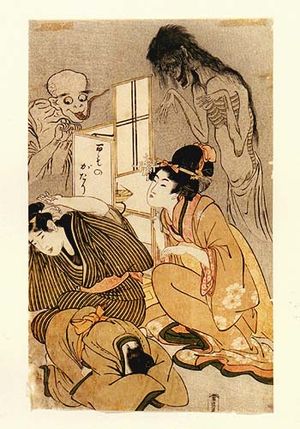Hyakumonogatari Kaidankai
- Hyakumonogatari Kaidankai
-

Cent Histoires de démons et d'esprits (
百物語怪談,
Hyakumonogatari Kaidan)
par Kitagawa Utamaro
Hyakumonogatari Kaidankai (百物語怪談会, litt. rassemblement de cent contes fantastiques) est un jeu oral très populaire de l'époque Edo au Japon.
Déroulement du jeu
Dans une pièce, à la nuit tombée, cent bougies sont allumées. Les joueurs se placent parmi les bougies et racontent des kaidan (怪談, histoires fantastiques). A chaque kaidan raconté, on souffle une bougie. La pièce devient de plus en plus sombre au cours du jeu. Les joueurs pensent que la dernière bougie éteinte permet d'invoquer un être surnaturel.
Wikimedia Foundation.
2010.
Contenu soumis à la licence CC-BY-SA. Source : Article Hyakumonogatari Kaidankai de Wikipédia en français (auteurs)
Regardez d'autres dictionnaires:
Hyakumonogatari Kaidankai — was a popular parlour game during Edo period Japan.The game was a simple one. In a room, as night fell, one hundred candles were lit. Guests and players gathered around the candles, taking turns telling kaidan. After each kaidan, a single candle… … Wikipedia
Yūrei — nihongo|Yūrei| are figures in Japanese folklore, analogous to Western legends of ghosts. The name consists of two kanji, ( yuu ), meaning faint or dim and wikt:霊 霊 ( rei ), meaning soul or spirit. Alternative names include 亡霊 (Borei) meaning… … Wikipedia
Kaidan — Kwaidan redirects here. For the book by Lafcadio Hearn, see . For Masaki Kobayashi s film of the same name, see Kwaidan (film). Kaidan (怪談) (sometimes transliterated kwaidan ) is a Japanese word consisting of two kanji: 怪 (kai) meaning “strange,… … Wikipedia
Aoandon — Illustration d un aoandon par Toriyama Sekien. Aoandon (青行燈, aoandon? … Wikipédia en Français
Kaidan — Pour les articles homonymes, voir Kwaïdan. Le mot kaidan (怪談, litt. histoire de l étrange, du mystérieux) est un mot japonais qui se compose de deux kanji : 怪 (kai) qui signifie « apparition étrange, mystérieuse, ou ensorcelante » … Wikipédia en Français
Bakemonogatari — 化物語 Genre Romance, Occult detective, Comedy … Wikipedia
Monogatari — (物語?) is a literary form in traditional Japanese literature, an extended prose narrative tale comparable to the epic. Monogatari is closely tied to aspects of the oral tradition, and almost always relates a fictional or fictionalized story, even… … Wikipedia
Aoandon — Aoandon, or Aoandō (青行灯 or 青行燈, blue andon ) is a creature illustrated by Toriyama Sekien in his Konjaku Hyakki Shūi . It was meant to represent the spirit that appeared during Hyakumonogatari Kaidankai meetings, after the last story was told.… … Wikipedia
Botan Dōrō — (牡丹燈籠 ) is a Japanese ghost story that is both romantic and horrific; it involves sex with the dead and the consequences of loving a ghost. It is sometimes known as Kaidan Botan Dōrō , based on the kabuki version of the story. Most commonly… … Wikipedia
Hyakki Yakō — by Kawanabe Kyōsai, collected in British Museum Hyakki Yakō (百鬼夜行; lit. Night Parade of One Hundred Demons ) was a Japanese folk belief. The belief holds that every year yōkai, the Japanese supernatural beings, will take to the streets during… … Wikipedia

